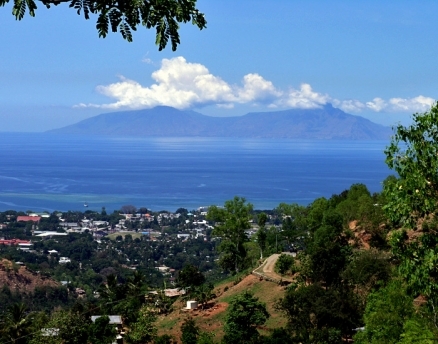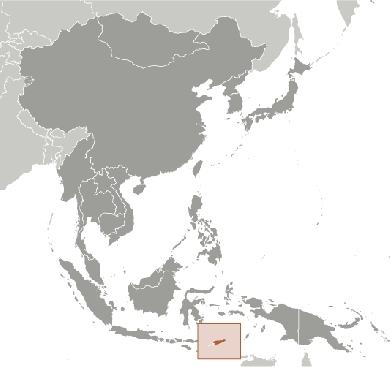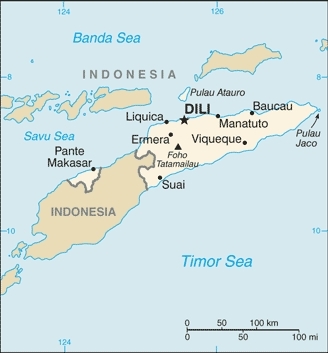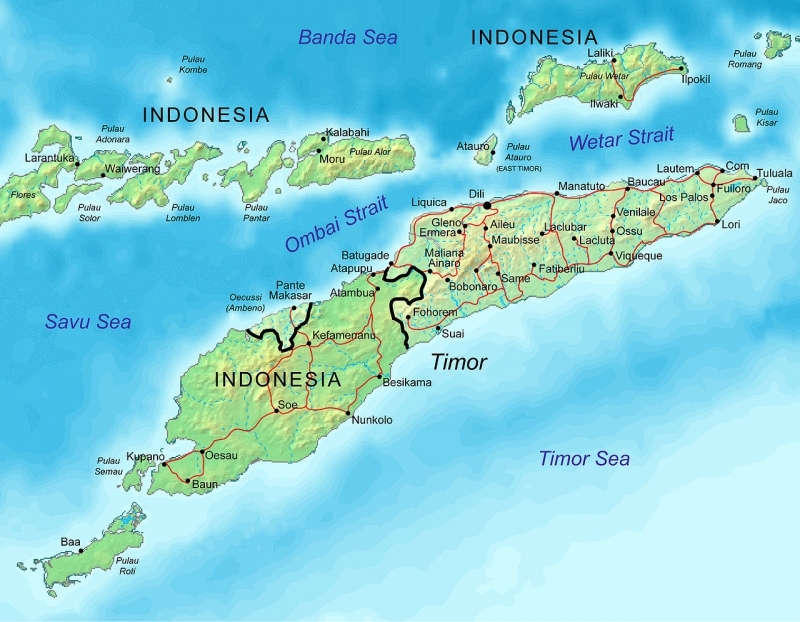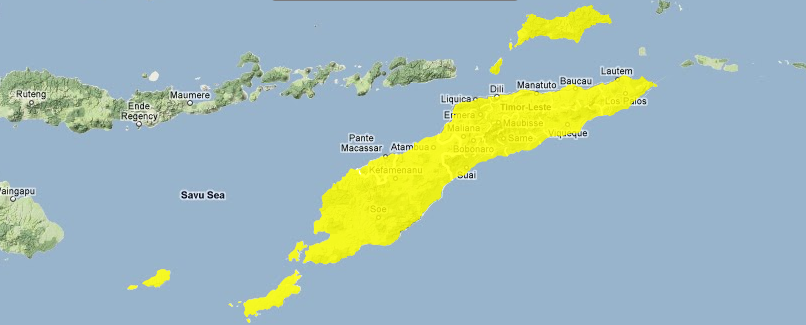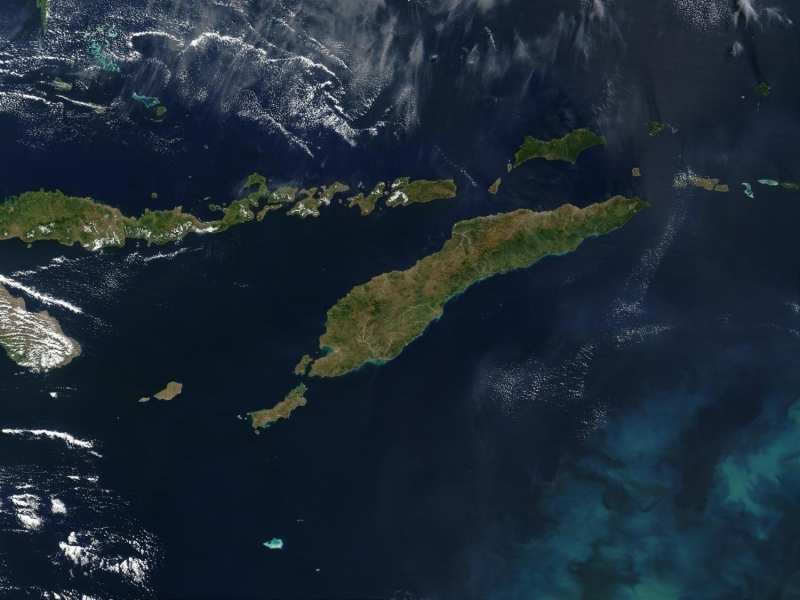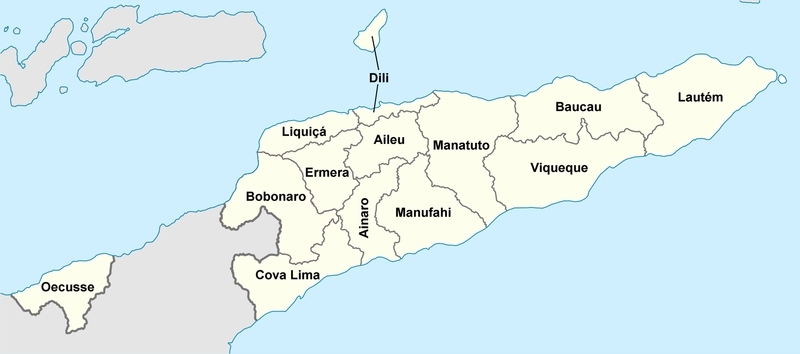Timor Leste / East Timor
Countries and Regions of the World Collection  Timor Leste (also known as East Timor) is a nation of about a million people in southeastern Asia, northwest of Australia in the Lesser Sunda Islands at the eastern end of the Indonesian archipelago. Timor-Leste includes the eastern half of the island of Timor and the the Oecussi (Ambeno) region on the northwest portion of the island of Timor, and the islands of Pulau Atauro and Pulau Jaco. On 20 May 2002, Timor-Leste was internationally recognized as an independent state after gaining independence from Indonesia.
Timor Leste (also known as East Timor) is a nation of about a million people in southeastern Asia, northwest of Australia in the Lesser Sunda Islands at the eastern end of the Indonesian archipelago. Timor-Leste includes the eastern half of the island of Timor and the the Oecussi (Ambeno) region on the northwest portion of the island of Timor, and the islands of Pulau Atauro and Pulau Jaco. On 20 May 2002, Timor-Leste was internationally recognized as an independent state after gaining independence from Indonesia.
Timor Leste fronts the Timor, Savu, and Banda seas.
Floods and landslides are common. Timor Leste is also susceptible to earthquakes, tsunamis, and tropical cyclones.
Its major environmental issues include widespread use of slash and burn agriculture which has led to deforestation and soil erosion.
Timor comes from the Malay word for "East".
The island of Timor is part of the Malay Archipelago and is the largest and easternmost of the Lesser Sunda Islands
The Portuguese began to trade with the island of Timor in the early 16th century and colonized it in mid-century.
Skirmishing with the Dutch in the region eventually resulted in an 1859 treaty in which Portugal ceded the western portion of the island.
Imperial Japan occupied Portuguese Timor from 1942 to 1945, but Portugal resumed colonial authority after the Japanese defeat in World War II.
East Timor declared itself independent from Portugal on 28 November 1975 and was invaded and occupied by Indonesian forces nine days later. It was incorporated into Indonesia in July 1976 as the province of Timor Timur (East Timor). An unsuccessful campaign of pacification followed over the next two decades, during which an estimated 100,000 to 250,000 individuals lost their lives.
On 30 August 1999, in a UN-supervised popular referendum, an overwhelming majority of the people of Timor-Leste voted for independence from Indonesia. Between the referendum and the arrival of a multinational peacekeeping force in late September 1999, anti-independence Timorese militias - organized and supported by the Indonesian military - commenced a large-scale, scorched-earth campaign of retribution. The militias killed approximately 1,400 Timorese and forcibly pushed 300,000 people into western Timor as refugees. Most of the country's infrastructure, including homes, irrigation systems, water supply systems, and schools, and nearly 100% of the country's electrical grid were destroyed.
On 20 September 1999, the Australian-led peacekeeping troops of the International Force for East Timor (INTERFET) deployed to the country and brought the violence to an end.
On 20 May 2002, Timor-Leste was internationally recognized as an independent state.
By the end of 2005, refugees had returned or had settled in Indonesia. Many refugees who left Timor-Leste in 2003 still reside in Indonesia and refuse repatriation.
In 2006, internal tensions threatened the new nation's security when a military strike led to violence and a breakdown of law and order. At Dili's request, an Australian-led International Stabilization Force (ISF) deployed to Timor-Leste, and the UN Security Council established the UN Integrated Mission in Timor-Leste (UNMIT), which included an authorized police presence of over 1,600 personnel. The ISF and UNMIT restored stability, allowing for presidential and parliamentary elections in 2007 in a largely peaceful atmosphere.
In February 2008, a rebel group staged an unsuccessful attack against the president and prime minister. The ringleader was killed in the attack and most of the rebels surrendered in April 2008. The government in 2008 resettled tens of thousands of an estimated 100,000 internally displaced persons (IDPs); most IDPs returned home by early 2009.
Since the unsuccessful attacks the government has enjoyed one of its longest periods of post-independence stability.
Contents
Geography
Location: Southeastern Asia, northwest of Australia in the Lesser Sunda Islands at the eastern end of the Indonesian archipelago; note - Timor-Leste includes the eastern half of the island of Timor, the Oecussi (Ambeno) region on the northwest portion of the island of Timor, and the islands of Pulau Atauro and Pulau Jaco
Geographic Coordinates: 8 50 S, 125 55 E
Area: 14,874 sq km
Land Boundaries: 228 km with Indonesia. Three stretches of land borders with Timor-Leste have yet to be delimited, two of which are in the Oecussi exclave area.
Coastline: 706 km
Maritime Claims:
territorial sea: 12 nm
contiguous zone: 24 nm
exclusive fishing zone: 200 nm
No maritime or EEZ boundaries have been established between the Timor Leste and Indonesia and maritime boundaries with Indonesia remain unresolved.
In 2007, Australia and Timor-Leste signed a 50-year development zone and revenue sharing agreement in lieu of a maritime boundary
Natural Hazards: floods and landslides are common; earthquakes; tsunamis; tropical cyclones
Terrain: Mountainous. The highest point is Foho Tatamailau (2,963 m).
Climate: tropical; hot, humid; distinct rainy and dry seasons
Source: Mats Halldin/Wikimedia Commons
Ecology and Biodiversity
Ecologically, Timor Leste is within the Timor and Wetar deciduous forests ecoregion. This ecoregion represents the semi-evergreen dry forests of Timor, Wetar, and some smaller islands in the provinces of Nusa Tenggara and Maluku in the eastern Indonesian Archipelago.
The seasonally dry forests found in this dynamic geologic setting are part of the region known as Wallacea, which contains a very distinctive fauna representing a mix of Asian and Australasian species.
The forest types in the ecoregion are dry deciduous, dry evergreen, and thorn forests.
Below 1,000 meters (m) the common tree species include Sterculia foetida and Calophyllum teysmannii (both of which produce oil-bearing seeds) and Aleurites moluccana. The lowland monsoon forests are dominated by Pterocarpus indicus, especially in the lowland monsoon forest remnants of West Timor and in the well-drained, dry soils north of Oebelo on the Bena coastal plain in south Timor.
Semi-evergreen rain forest is found on southern hill slopes at Buraen, which are kept moist by southeast trade winds, and on the Damar Islands.
East Timor's few remaining forest patches contain the last natural stands of Eucalyptus urophylla (now widely used in plantations) and Santalum album, the sandalwood tree. The shrub layer in these forests includes Verbenaceae, Rubiaceae, and Euphorbiaceae, and the herbs include Acanthaceae, Tacca palmata, the root parasite Balanophora fungosa, and ground orchids such as Corymborkis.
Four types of savanna are found here, each characterized by palm, Eucalyptus, Acacia spp., and Casuarina spp.
On Timor's larger coastal plains, the vegetation ranges from grassland to open stands of deciduous trees, with increasing forest cover toward the moister southern mountains.
The bird fauna consists of about 229 species. The bird fauna also represents a mix of mostly Asian species with some Australasian birds. Endemism is extremely high for these islands, with thirty-five species that are endemic or near endemic. The ecoregion encompasses with the Timor and Wetar Endemic Bird Area (EBA). Thirty-five restricted-range bird species are found in the Timor and Wetar EBA, twenty-three of which are found nowhere else on Earth. Five of these species are considered vulnerable: black cuckoo-dove (Turacoena modesta), Wetar ground-dove (Gallicolumba hoedtii), Timor green-pigeon (Treron psittacea), Timor imperial-pigeon (Ducula cineracea), and iris lorikeet (Psitteuteles iris).
Timor also harbors the endemic and rare Timor python (Python timoriensis).
Other than one remaining large block of forest near the center of Timor Island, this ecoregion contains only fragments of natural habitat. Nearly two-thirds of the original extent of forest has been cleared (Deforestation), mostly for agriculture. Most of the original monsoon forest on these islands has been replaced by savanna and grassland. On East Timor, the south escarpment of the Fuiloro limestone plateau originally was covered by primary rain forest, but in the 1950s this area was degraded to secondary forest. Wetar is threatened by poorly managed gold mines that have been passed from company to company, causing major environmental damage. There are twenty-four protected areas that include roughly 10 percent (3,661 square-kilometers [km2]) of the ecoregion area, but all are small, with the average size being only 152 km2
Deforestation is occurring very rapidly as people burn the forests for hunting, shifting cultivation, and fodder production. Logging has also grown in importance; for instance, Damar Island was densely forested until the late 1980s, when logging began on a large scale to supply timber to the outer arc islands, where the forests had already been more heavily exploited. As a result, fire-resistant Casuarina junghuhniana grows in pure stands in cleared areas, and Mt. Mutis, on West Timor, is covered almost exclusively by Eucalyptus urophylla. This problem is worsening as the human populations expand. Savanna areas are especially prone to erosion. This ecoregion is highly threatened. In previous centuries, many forest resources such as sandalwood were depleted through uncontrolled exploitation.
See also: Biological diversity in Wallacea
Southeast of the island of Timor (center), a phytoplankton bloom is coloring the waters of the Timor Sea, which separates Timor from northwestern Australia. To the north of Timor is Flores, which is home to numerous active volcanoes. (The red dots are due to fire, not volcanic activity.) The eastern half of Timor, as well as an exclave to the west and a few offshore islands, constitute the country of Timor-Leste. The western portion of Timor and the remaining islands (including Flores) belong to Indonesia. Image courtesy of NASA.
People and Society
Population: 1,201,255 - other estimates range as low as 800,000 (July 2012 est.)
Timor-Leste is located in Southeast Asia, on the southernmost edge of the Indonesian archipelago, northwest of Australia. The country includes the eastern half of Timor island as well as the Oecussi exclave in the northwest portion of Indonesian West Timor, and the islands of Atauro and Jaco. The mixed Malay and Pacific Islander culture of the Timorese people reflects the country’s location at the juncture of those two cultural areas. After centuries of Portuguese colonial rule, a substantial majority of the population identifies itself as Roman Catholic. Some of those who consider themselves Catholic practice a mixed form of religion that includes local animist customs. Approximately 50% of Timorese speak Portuguese, 55% speak Bahasa Indonesia, and 31% speak English, according to the 2010 census; the percentages are likely significantly lower among adults. Over 85% speak Tetum, the most common of the local languages; about 45% speak Tetum Prasa, the form of Tetum dominant in the Dili district. Mambae, Kemak, and Fataluku are also widely spoken. This linguistic diversity is enshrined in the country's constitution, which designates Portuguese and Tetum as official languages and English and Bahasa Indonesia as working languages.
Ethnic Groups: Austronesian (Malayo-Polynesian), Papuan, small Chinese minority
Age Structure:
0-14 years: 33.8% (male 202,431/female 195,895)
15-64 years: 62.5% (male 374,659/female 361,983)
65 years and over: 3.6% (male 20,160/female 22,706) (2011 est.)
Population Growth Rate: 25.43 births/1,000 population (2012 est.)
Birthrate: 25.43 births/1,000 population (2012 est.)
Death Rate: 5.86 deaths/1,000 population (July 2012 est.)
Net Migration Rate: 0 migrant(s)/1,000 population (2012 est.)
Life Expectancy at Birth: 68.27 years
male: 65.85 years
female: 70.81 years (2012 est.)
Total Fertility Rate: 3.06 children born/woman (2012 est.)
Languages: Tetum (official), Portuguese (official), Indonesian, English. There are about 16 indigenous languages; Tetum, Galole, Mambae, and Kemak are spoken by a significant portion of the population. Literacy (age 15 and over can read and write): 58.6% Urbanization: 28% of total population (2010) growing at an annual rate of chnage of 5% (2010-15 est.) Access to improved sources of drinking water: 69% of population Access to improved sanitation facilities: 50% of population History Portuguese and Dutch traders made the first western contact with Timor in the early 16th century. Sandalwood and spice traders as well as missionaries maintained sporadic contact with the island until 1642, when the Portuguese moved into Timor in strength. The Portuguese and the Dutch, based at the western end of the island in Kupang, battled for influence until agreeing to the present-day borders in 1906. Imperial Japan occupied East Timor from 1942-45. Portugal resumed colonial authority over East Timor in 1945 after the Japanese defeat in World War II. Following a military coup in Lisbon in April 1974, Portugal began a rapid and disorganized decolonization process in most of its overseas territories, including East Timor. Political tensions--exacerbated by Indonesian involvement--heated up, and on August 11, 1975, the Timorese Democratic Union Party (UDT) launched a coup d'etat in Dili. A brief but bloody civil war followed, and the Revolutionary Front for an Independent East Timor (FRETILIN) pushed UDT forces into Indonesian West Timor. Shortly after the FRETILIN victory in late September, Indonesian forces began incursions into East Timor. On October 16, five journalists from Australia, Britain, and New Zealand were murdered in the East Timorese town of Balibo shortly after they had filmed regular Indonesian army troops invading East Timorese territory. On November 28, FRETILIN declared East Timor an independent state, and Indonesia responded by launching a full-scale military invasion on December 7. On December 22, 1975 the UN Security Council called on Indonesia to withdraw its troops from East Timor. Declaring a provisional government made up of Timorese allies on January 13, 1976, the Indonesian Government said it was acting to forestall civil strife in East Timor and to prevent the consolidation of power by the FRETILIN party. The Indonesians claimed that FRETILIN was communist in nature, while the party's leadership described itself as social democratic. Coming on the heels of the communist victories in Vietnam, Cambodia, and Laos, the Indonesian claims were accepted by many in the West. Nonetheless, the widespread popular support shown for the guerilla resistance launched by the Timorese made clear that the Indonesian occupation was not welcome. In the absence of a legitimate act of self-determination, the United Nations never recognized the incorporation of East Timor into Indonesia. The Indonesian occupation of Timor was initially characterized by a program of brutal military repression. Beginning in the late 1980s, however, the occupation was increasingly characterized by programs to win the "hearts and minds" of the Timorese through the use of economic development assistance and job creation while maintaining a strict policy of political repression. Serious human rights violations--such as the 1991 Santa Cruz massacre--continued. Estimates of the number of Timorese who lost their lives to violence and hunger during the Indonesian occupation range from 100,000 to 250,000. On January 27, 1999, Indonesian President B.J. Habibie announced his government's desire to hold a referendum in which the people of East Timor would choose between autonomy within Indonesia and independence. Under an agreement among the United Nations, Portugal, and Indonesia, the referendum was held on August 30, 1999. When the results were announced on September 4--78% voted for independence with a 98.6% turnout--Timorese militias organized and supported by the Indonesian military (TNI) commenced a large-scale, scorched-earth campaign of retribution. While pro-independence FALINTIL guerillas remained cantoned in UN-supervised camps, the militia and the TNI killed approximately 1,300 Timorese and forcibly relocated as many as 300,000 people into West Timor as refugees. The majority of the country's infrastructure, including homes, irrigation systems, water supply systems, and schools, and nearly 100% of the country's electrical grid were destroyed. On September 20, 1999, Australian-led peacekeeping troops of the International Force for East Timor (INTERFET) deployed to the country, bringing the violence to an end. Timor-Leste became a fully independent republic with a parliamentary form of government on May 20, 2002, after approximately two and a half years under the authority of the UN Transitional Administration in East Timor (UNTAET). The country's first parliament was formed from the 88-member Constituent Assembly chosen in free and fair, UN-supervised elections in August 2001. The FRETILIN Party won the majority of Assembly seats. Mari Alkatiri, FRETILIN's Secretary General, became the first Prime Minister, and FRETILIN dominated the country's 29-member cabinet. Xanana Gusmao was elected in free and fair elections on April 14, 2002 as President. UNTAET's mandate ended with East Timor's independence, but a successor organization, the UN Mission for the Support of East Timor (UNMISET), was established to provide additional support to the government. UNMISET's mandate expired on May 20, 2005 after the UN Security Council unanimously approved the creation of a small special political mission in Timor-Leste, the UN Office in Timor-Leste (UNOTIL), to take its place. Under the constitution ratified in March 2002, "laws and regulations in force continue to be applicable to all matters except to the extent that they are inconsistent with the Constitution." The Government of Timor-Leste has enacted a significant amount of legislation, including criminal and procedure codes. In February 2006, approximately 400 military personnel (from a total military strength of 1,400) petitioned President Gusmao to address their complaints of discrimination. The commander of the country's armed forces (F-FDTL) dismissed the petitioners, who reacted with a demonstration that flared into violence on April 28. In response to the escalating unrest, large numbers of people began to flee their homes for internally displaced persons (IDP) camps or the outlying districts. The violence mounted with a series of deadly clashes among the F-FDTL, dissident military forces, civilians, and some police occurring on May 23-25. Mob and gang violence took over the capital, resulting in additional deaths, widespread destruction of property, and the continued displacement of thousands of Dili residents. At the peak of the crisis, there was a national total of about 150,000 IDPs. Facing a full-scale collapse of civil order, the Government of Timor-Leste on May 28 asked the Governments of Australia, Malaysia, New Zealand, and Portugal to send security forces to stabilize the country. Under heavy domestic political pressure, Prime Minister Alkatiri resigned on June 27. Jose Ramos-Horta--the Foreign and Defense Minister in the Alkatiri government--became Prime Minister on July 10, and a new cabinet was sworn in on July 14, 2006. On August 25, 2006 the UN Security Council passed Resolution 1704, creating the United Nations Integrated Mission in Timor-Leste (UNMIT). UNMIT’s mandate includes assisting in restoring stability, rebuilding the institutions comprising the security sector, supporting the Government of Timor-Leste in conducting the 2007 presidential and parliamentary elections, and achieving accountability for the crimes against humanity and other atrocities committed in 1999. UNMIT has a large policing component. In May 2009, UNMIT police began transferring primary policing responsibility to the Timorese Police Force (PNTL) on a district-by-district basis. In March 2011, UNMIT completed its handover of executive policing authority to the PNTL. While the UN Security Council has extended UNMIT's mandate annually since 2006, UNMIT and the Government of Timor-Leste are making plans for the withdrawal of UNMIT police and personnel by the end of 2012. (UNMIT's own website provides additional information: http://www.un.org/en/peacekeeping/missions/unmit/ (Timor Leste / East Timor) )
Timor-Leste held presidential elections in the spring of 2007. On April 9, voters chose from a slate of eight candidates. With a voter turnout of almost 82%, the top two finishers were the FRETILIN Party candidate Francisco "Lu-olo" Guterres, who received 28% of the vote, and Jose Ramos-Horta, who received 22% of the vote after stepping down as Prime Minister to run as an independent candidate with the endorsement of then-President Xanana Gusmao. In the runoff election on May 9, required because the electoral law specifies that a candidate must win a majority, Ramos-Horta won by a landslide, receiving 69% of the vote. The presidential elections experienced some procedural glitches, but were largely free of violence and significant irregularity.
The Government of Timor-Leste held parliamentary elections on June 30, 2007. Observers agree that the elections were generally free and fair. FRETILIN won the most seats in parliament, but no single party won a majority and the various parties did not agree to form a national unity government. On August 6, 2007, President Ramos-Horta asked Xanana Gusmao, the leader of a coalition with a majority of the seats in the parliament (the Alliance with a Parliamentary Majority or AMP), to form a government. Gusmao was sworn in as Prime Minister along with most of the other ministers in the new government on August 8, 2007. Although the June elections proceeded in a largely peaceful atmosphere, violent disturbances broke out in several areas of Dili and the eastern districts of Baucau and Viqueque when the president announced the formation of a new government as FRETILIN partisans took to the streets to protest that they had not been given an opportunity to form a government. The unrest subsided within days, but the affected areas remained tense for several weeks thereafter and FRETILIN continues to assert that the AMP government is unconstitutional although it participates actively in the work of the national parliament.
Upon taking office, the AMP government put the problems of the internally displaced persons, the petitioners, and other issues flowing from the 2006 crisis at the top of its policy agenda. The Ministry of Social Solidarity launched an IDP reintegration program, including resettlement assistance and financial support, that allowed for the gradual closing of the camps. All but a few of the nearly 150,000 IDPs had returned home or been resettled by July 2010. The government also addressed the grievances of the military petitioners. Accepting monetary compensation, they closed their encampment in Dili and returned to their homes.
On February 11, 2008, followers of former military police commander and fugitive Major Alfredo Reinado attacked President Ramos-Horta. Ramos-Horta sustained gunshot injuries and was airlifted to Australia for medical treatment. Prime Minister Gusmao escaped unharmed after his bodyguards thwarted a separate attack against him the same day as the attack on the president. The president's bodyguards killed Reinado. The government, with the approval of the national parliament, immediately imposed a state of siege that temporarily imposed a curfew, curtailed freedom of assembly, and gave security forces greater latitude for arrests and searches. These emergency measures were scaled back as conditions stabilized over the following weeks. President Ramos-Horta returned to Timor-Leste on April 17. The state of emergency was lifted completely when the remainder of Reinado’s followers surrendered to authorities on April 29, 2008. Most of them were convicted on March 3, 2010, for their involvement in the assassination attempt. Ramos-Horta subsequently commuted the sentences of the defendants, and they were released. Since 2008, the government has succeeded in maintaining stability throughout the country. Presidential and parliamentary elections are expected to take place the first half of 2012.
Government
Government Type: Republic
Capital: Dili - 166,000 (2009)
Administrative divisions: 13 administrative districts; Aileu, Ainaro, Baucau, Bobonaro (Maliana), Cova-Lima (Suai), Dili, Ermera (Gleno), Lautem (Los Palos), Liquica, Manatuto, Manufahi (Same), Oecussi (Ambeno), Viqueque. Note: administrative divisions have the same names as their administrative centers (exceptions have the administrative center name following in parentheses)
Independence Date: 28 November 1975 (independence proclaimed from Portugal); Note - 20 May 2002 is the official date of international recognition of Timor-Leste's independence from Indonesia
Legal System: civil law system based on the Indonesian model; note - new penal code based on the Portuguese model was passed by Parliament and promulgated in 2009; new civil code expected to be promulgated in 2011. Timor Leste ahas not submitted an International Court of Justice (ICJ) jurisdiction declaration; but accepts International criminal court (ICCt) jurisdiction
International Environmental Agreements
Timor Leste is party to international agreements on: Biodiversity, Climate Change, Climate Change-Kyoto Protocol, and Desertification.
Agriculture
Agricultural products: coffee, rice, corn, cassava, sweet potatoes, soybeans, cabbage, mangoes, bananas, vanilla
Irrigated Land: 140 sq km (2008)
Resources
Natural Resources: gold, petroleum, natural gas, manganese, marble
Land Use:
Economy
Timor-Leste is one of the least developed countries in the world, with basic income, health, and literacy levels similar to those of countries in sub-Saharan Africa. Infrastructure is inadequate in urban and rural areas. Unemployment and underemployment combined are estimated to be as high as 70%. Official statistics indicate that around 40% of the country's population lives below the poverty line.
In late 1999, about 70% of the economic infrastructure of Timor-Leste was laid waste by Indonesian troops and anti-independence militias. Three hundred thousand people fled westward. Over the next three years a massive international program, manned by 5,000 peacekeepers (8,000 at peak) and 1,300 police officers, led to substantial reconstruction in both urban and rural areas.
By the end of 2005, refugees had returned or had settled in Indonesia.
The country continues to face great challenges in rebuilding its infrastructure, strengthening the civil administration, and generating jobs for young people entering the work force.
The development of oil and gas resources in offshore waters has greatly supplemented government revenues. This technology-intensive industry, however, has done little to create jobs for the unemployed because there are no production facilities in Timor-Leste. Gas is piped to Australia.
Timor-Leste has received oil and gas revenues since 2005 as major projects in the Joint Petroleum Development Area that Timor-Leste shares with Australia have come online. The government set up a special Petroleum Fund in 2005 to ensure the sustainable use of its revenues over the long term. Petroleum Fund assets reached $8.3 billion in 2011.
The economy is dependent on government spending (financed by petroleum revenues) and assistance from international donors. Private sector development has lagged due to human capital shortages, infrastructure weakness, an incomplete legal system, and an inefficient regulatory environment.
In June 2005, the National Parliament unanimously approved the creation of a Petroleum Fund to serve as a repository for all petroleum revenues and to preserve the value of Timor-Leste's petroleum wealth for future generations. The Fund held assets of US$9.3 billion as of December 2011.
The economy continues to recover strongly from the mid-2006 outbreak of violence and civil unrest, which disrupted both private and public sector economic activity. All of the estimated 100,000 internally displaced persons returned home by early 2009.
Government spending increased markedly from 2009 through 2011, primarily on basic infrastructure, including electricity and roads. Limited experience in procurement and infrastructure building has hampered these projects. The underlying economic policy challenge the country faces remains how best to use oil-and-gas wealth to lift the non-oil economy onto a higher growth path and to reduce poverty. The parliament in late 2011 approved an ambitious, infrastructure-focused $1.67 billion budget for 2012 that would allow the government to borrow for the first time in its 10-year history.
GDP: (Purchasing Power Parity): $3.366 billion (2011 est.)
GDP: (Official Exchange Rate): $700 million note: non-oil GDP (2011 est.)
GDP- per capita (PPP): $3,100 (2011 est.)
GDP- composition by sector:
agriculture: 27%
industry: 18.1%
services: 54.8% (2011 est.)
Industries: printing, soap manufacturing, handicrafts, woven cloth
Currency: US dollar
